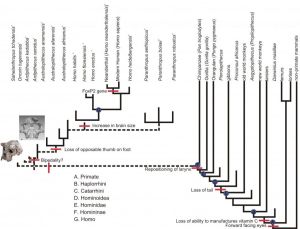This is an old claim from creationists who really don’t understand evolution… or apparently reproduction. I don’t consider it a ‘weakness’ of evolution, but it is an attack against it.
If humans evolved from monkeys, how come monkeys still exist?
First let me take a moment to say that “monkey” is a terrible term for what the creationists are using here. Monkey is not a formal group. There are 260 odd species of monkey (both old world and new world monkeys), but this group specifically excludes apes (including chimpanzees, humans, gorillas, gibbons, etc).
Let me ask this question a slightly different way and you’ll see one of the two problems with this question
“If you came from your dad, how come your dad still exists?” Yes, that is exactly what the question above is asking. If we go with the assumption that evolution is a linear progression (which is not true as we’ll see in a moment), then suggesting that parent organisms cannot survive once daughter organisms are born is obviously silly.
And with all due respect to Carl Sagan, this is something he got wrong in Cosmos. Evolution is not a ladder. It’s not a sequence of continually more advanced organisms. It’s not fish evolving into amphibians which evolve into reptiles which evolve into mammals, etc.
So what is it?
Let me ask another question that will help. “If you came from your dad, how come your cousin exists?”
You are your cousin exist at roughly the same time. You probably look a fair bit alike. So, how can he possible exist if evolution is true?
Because you and your cousin have a common ancestor. That is, your grandfather and grandmother. You and your cousin will continue to live, side-by-side (well, at least, contemporaneously), grow have your own offspring, etc.
Eventually, your family and your cousin’s families will be widely separated. You and your cousin’s great-great grandchildren probably won’t even realize that they are directly related through your grandfather. That happens, families drift apart, move, change attitudes, lifestyles, etc.
Pretty soon, you might not even realize that the two families (based on you and your cousin) are still closely related.
Hey look. I just described how evolution actually works.
Humans did not come from chimpanzees. Humans and chimpanzees had a common ancestor that was neither human nor chimpanzee. This creature lived about 6.5 million years ago. Using genetic clocks, we know that what would become modern gorillas split off from the human lineage, and then what would become chimpanzees did.
Fossil evidence is rare, because of the acidic nature of rainforest soils, but there are a few contenders. The most recent research (PDF and PDF) indicates that the various Australopithecus species may be a branch of the human line and not our direct ancestors. That’s OK, science changes as new discoveries come to light. It’s not a problem.
I’ve shown these before, but let me give you a graphical view of the kind of relationship I’m talking about.
{click to make larger}
This is the family tree of humans… as far as we know. As I said, fossil evidence is sparse at best… but there is some. And it does fit nicely with what we know genetically and morphologically.
In the above diagram, lines that extend all the way to the names are extant species. Any line that stops before then represents an extinct species. The letters in blue circles show that everything connected to that blue circle is a member of that named group. The red lines indicate traits that all members after that red line share.
For example, every species on this tree that is to the left of Proconsul africanus does not have a tail. The ones to the right, do have tails.
The question is, did the gorilla evolve into humans? The answer, of course, is no. This diagram shows that gorillas and humans had a common ancestor way back in time (4-8 million years). That common ancestor was also the common ancestor of chimpanzees and all the other hominids. A more recent common ancestor (point G) was the common ancestor of all members of genus Homo.
BTW: In case it comes up. This chart isn’t the evidence for this. The cladogram displays the results of (literally) thousands of peer-reviewed papers that cover everything from fossils to modern genetic comparisons. A tiny bit of all that evidence is represented by the links below.
The creationist claim in this case, is based on a fundamental misunderstanding of evolution. Of course, even without that misunderstanding, it’s still wrong. Which goes to show the kinds of problems that creationists have with actual science.
- Wood, Bernard; Richmond, Brian G. (2000). “Human evolution: taxonomy and paleobiology”. Journal of Anatomy 197 (1): 19–60. doi:10.1046/j.1469-7580.2000.19710019.x. PMC 1468107. PMID 10999270.
- Ajit, Varki and David L. Nelson. 2007. Genomic Comparisons of Humans and Chimpanzees. Annu. Rev. Anthropol. 2007. 36:191–209: “Sequence differences from the human genome were confirmed to be ∼1% in areas that can be precisely aligned, representing ∼35 million single base-pair differences. Some 45 million nucleotides of insertions and deletions unique to each lineage were also discovered, making the actual difference between the two genomes ∼4%.”
- Ruvolo, M. 1997. Genetic Diversity in Hominoid Primates. Annual Review of Anthropology , Vol. 26, (1997), pp. 515-540
- Ruvolo, Maryellen (1997). “Molecular phylogeny of the hominoids: inferences from multiple independent DNA sequence data sets”. Molecular Biology and Evolution 14 (3): 248–265. PMID 9066793.
- Begun, David R. 2010. Miocene Hominids and the Origins of the African Apes and Humans. Annual Review of Anthropology, Vol. 39: 67 -84
- Wood, Bernard A. (2009). “Where does the genus Homo begin, and how would we know?”. In Grine, Frederick E.; Fleagle, John G.; Leakey, Richard E. (eds). The First Humans: Origin and Early Evolution of the Genus Homo. London, UK: Springer. pp. 17–27. ISBN 978-1-4020-9979-3.
- Wood B (1996). “Human evolution”. BioEssays 18: 945–954. doi:10.1002/bies.950181204.

